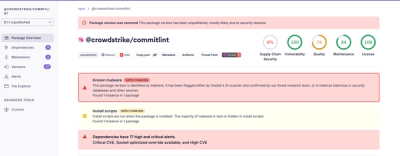
Research
Malicious fezbox npm Package Steals Browser Passwords from Cookies via Innovative QR Code Steganographic Technique
A malicious package uses a QR code as steganography in an innovative technique.
cldr-segmentation
Advanced tools
Text segmentation library for JavaScript.
This library provides CLDR-based text segmentation capabilities in JavaScript. Text segmentation is the process of identifying word, sentence, and other boundaries in a text. The segmentation rules are published by the Unicode consortium as part of the Common Locale Data Repository, or CLDR, and made freely available to the public.
Good question. Most of the time, that'll probably work fine. However, it's not always obvious where words or sentences should start or end. Consider this sentence:
I like Mrs. Murphy. She's nice.
Splitting only on periods will give you ["I like Mrs. ", "Murphy. ", "She's nice."], which probably isn't what you wanted - the period after Mrs doesn't indicate the end of the sentence.
In addition, other languages use different segmentation rules than English. For example, identifying sentence boundaries in Japanese is a little more difficult because sentences tend to end with \u3002 - the ideographic full stop - as opposed to a period. The CLDR contains support for hundreds of languages, meaning you don't have to consider every language when dealing with international text.
Cldr-segmentation is published as both a UMD module and an ES6 module, meaning it should work in node via require or import and the browser via a <script> tag. In the browser, use window.cldrSegmentation to access the library's functionality.
UMD module:
const cldrSegmentation = require("cldr-segmentation");
ES6 module:
import * as cldrSegmentation from 'cldr-segmentation'
cldrSegmentation.sentenceSplit("I like Mrs. Murphy. She's nice.");
// => ["I like Mrs. ", "Murphy. ", "She's nice."]
You'll notice that Mrs. was treated as the end of a sentence. To avoid this, use the suppressions for the language you care about. Suppressions are essentially arrays of strings. Each string represents a series of characters after which there should not be a break. Using the English suppressions for the example above yields better results:
var supp = cldrSegmentation.suppressions.en;
cldrSegmentation.sentenceSplit("I like Mrs. Murphy. She's nice.", supp);
// => ["I like Mrs. Murphy. ", "She's nice."]
If you'd like to iterate over each sentence instead of splitting, use a BreakIterator:
var breakIter = new cldrSegmentation.BreakIterator(supp);
var str = "I like Mrs. Murphy, she's nice.";
breakIter.eachSentence(str, (sentence, start, stop) => {
// do something
});
Suppressions for all languages are available via cldrSegmentation.suppressions.all.
Word, line, and grapheme cluster segmentation are supported:
cldrSegmentation.wordSplit("I like Mrs. Murphy. She's nice.");
// => ["I", " ", "like", " ", "Mrs", ".", " ", "Murphy", ".", "She's", " ", "nice", "."]
Also available are the lineSplit and graphemeSplit functions.
When using a break iterator:
var breakIter = new cldrSegmentation.BreakIterator(supp);
var str = "I like Mrs. Murphy, she's nice.";
breakIter.eachWord(str, (word, start, stop) => {
// do something
});
Also available are the eachLine and eachGraphemeCluster functions.
Suppressions are just strings after which a break should not occur. This library comes with a set of common suppressions for a variety of languages, but you may want to add your own. Suppression objects can be merged. For example, here's how to add "Dr." to the set of English suppressions:
var customSupps = cldrSegmentation.Suppressions.create(['Dr.']);
var supps = cldrSegmentation.suppressions.en.merge(customSupps);
cldrSegmentation.sentenceSplit("We love Dr. Strange. He's cool.", supps);
Suppression objects are just plain 'ol Javascript objects with a single shouldBreak function that returns a boolean. The function is passed a cursor object positioned at the index of the proposed break. Cursors deal exclusively with Unicode codepoints, meaning your custom suppression logic will need to be implemented in those terms. For example, let's create a custom suppression function that doesn't allow breaks after sentences that end with the letter 't'.
class TeeSuppression {
shouldBreak(cursor) {
var position = cursor.logicalPosition;
// skip backwards past spaces and periods
do {
let cp = cursor.getCodePoint(position);
position --;
} while (cp === 32 || cp === 46);
// we skipped one too many in the loop
position ++;
// if the ending character is 't', return false;
// otherwise return true
return cursor.getCodePoint(position) !== 116;
}
}
Note that you don't have to use ES6 classes. It's equally valid to create a simple object:
let teeSuppression = {
shouldBreak: (cursor) => {
// logic here
}
}
Tests are written in Jasmine and can be executed via jasmine-node:
npm install -g jasmine-nodejasmine-node specWritten and maintained by Cameron C. Dutro (@camertron).
Copyright 2017 Cameron Dutro, licensed under the MIT license.
2.2.1
FAQs
CLDR text segmentation for JavaScript
The npm package cldr-segmentation receives a total of 1,719 weekly downloads. As such, cldr-segmentation popularity was classified as popular.
We found that cldr-segmentation demonstrated a not healthy version release cadence and project activity because the last version was released a year ago. It has 1 open source maintainer collaborating on the project.
Did you know?

Socket for GitHub automatically highlights issues in each pull request and monitors the health of all your open source dependencies. Discover the contents of your packages and block harmful activity before you install or update your dependencies.

Research
A malicious package uses a QR code as steganography in an innovative technique.

Research
/Security News
Socket identified 80 fake candidates targeting engineering roles, including suspected North Korean operators, exposing the new reality of hiring as a security function.

Application Security
/Research
/Security News
Socket detected multiple compromised CrowdStrike npm packages, continuing the "Shai-Hulud" supply chain attack that has now impacted nearly 500 packages.